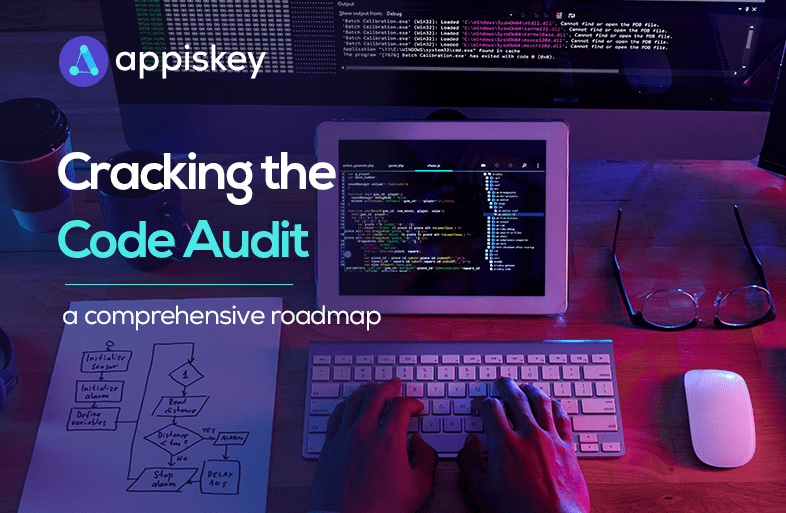Cracking the Code Audit: A Comprehensive Roadmap

Be it a website, a mobile app, or desktop software, a code audit is no less than a knight in shining armor ready to take on bugs. The same bugs and loopholes can raise hell for developers if not tackled on time. This is why code audit is introduced into the codebase.
With new developers joining to add new features & functionalities to an existing website, mobile app, etc. It’s inevitable for that particular piece of software to grow. The same reason is why it becomes easy for clients & C2 to get lost in the transition. Thus, to keep the codebase understandable, faultless, and most importantly maintainable, developers resort to code audits.
Needless to say, no website or application is ever safe from security compromises. According to a couple of reports online, an estimated 20% of bugs in software programs go unnoticed. Whereas CISQ revealed that US-based software companies lose up to $607 billion a year due to software bugs. Software companies can easily avoid such snafus with code audits, and this blog will cover all the basics that developers will need to know before implementing them.
Familiarizing With Basics
What is Code Audit?
Don’t confuse code review with code audit. Code review is a collaborative effort where one or more developers comprehensively examine a piece of code. They then provide feedback pertaining to the design, performance, functionality, readability, and compliance with industry standards.
On the other hand, a code audit encompasses a comprehensive & independent analysis of the code done by an external expert or a tool. The key purpose of a code audit is to identify vulnerabilities, technical debt, and compliance issues in the code.
Software developers can use code audits for a myriad of purposes including code optimization, due diligence, and security testing. Code audit allows developers to boost the efficiency of their code, exposes vulnerabilities in there so they can meet with a prompt resolution, ensures the code is compliant with security standards, and identifies out-of-date coding practices.
Types of Code Audit
Developers utilize different types of code audits to ensure the integrity of code. Each type caters to some specific goals and focus areas. These are the types of code audits commonly followed:
Manual Code Audit
The type of code audit involves actual developers examining the source code to identify issues, vulnerabilities, and areas of improvement in the codebase. This process relies on expertise and a thorough understanding of coding best practices, security concerns, and industry standards. So practicing developers must know what areas to get a grasp over.
Manual code audits allow for detailed analysis, and customized evaluations. It can uncover complex issues that automated tools may miss.
Backend Code Audit
A backend code audit involves an in-depth evaluation of the server-side code and infrastructure that powers an application or system. It focuses on scrutinizing the backend codebase, databases, APIs, and server configurations for potential vulnerabilities, performance bottlenecks, scalability issues, and compliance with industry-relevant practices.
This audit fortifies back-end security and efficiency and involves examining authentication mechanisms to ensure a robust backend implementation.
Frontend Code Audit
This particular code audit involves a comprehensive examination of the client-side code, including HTML, CSS, and JavaScript that powers the user interface and interactions of a website or application. It further identifies potential bugs, code inefficiencies, security vulnerabilities, and areas for improvement.
Front-end code audit further ensures a smooth and robust front-end implementation that delivers an impeccably seamless user experience across various platforms and devices.
Security Code Audit
This type of code audit provides a systematic review of software code to identify and mitigate security vulnerabilities and weaknesses. It involves analyzing the codebase for common security issues including input validation flaws, authentication & authorization vulnerabilities, etc.
The security code audit is focused solely on uncovering the vulnerabilities that exploiters could eventually enter and provides recommendations to improve the overall security of the software.
Infrastructure Code Audit
An infrastructure code audit involves evaluating the configuration, deployment scripts, and infrastructure-as-code (IaC) templates to manage the underlying infrastructure of an application or system. It aims to ensure the infrastructure is properly designed, secure, scalable, and compliant with the best practices.
This type of code audit includes examining network configurations, access controls, and disaster recovery mechanisms. Additionally, in a bid to enhance the reliability, efficiency, and maintainability of the infrastructure setup, this code audit identifies misconfigurations that might lead to potential security risks and performance bottlenecks.
What Steps Does a Code Audit Generally Include?
The whole process behind code auditing requires both time and thorough reviews of the source code. Most experts recommend tackling the code auditing process through an amalgamation of automated & manual testing to avoid losing focus of the project. All in all, the code auditing process is backed by these steps:
Start Off By Manually Studying the Code
Testing the code at hand manually provides developers with an opportunity to gain insights into the functioning of a project. This approach facilitates bug detection, business logic, flow evaluation, and conducting a security audit of the source code.
During manual testing, developers evaluate the codebase for its robustness. They then verify the integrity of the code, assess the connectivity of styles, and identify potential instances of duplication.
Carry Out an Automated Code Study
An automated code study allows developers to check the implemented business logic of the code. This includes examining the main controllers to ensure adherence to object-oriented programming principles such as proper inheritance, polymorphism, programming patterns, and object encapsulation.
Additionally, manual code testing addresses language-specific concerns during the code audit. For example, in Java, issues like security vulnerabilities such as garbage collection and memory leaks can be comprehensively checked and monitored.
Check For Outdated Versions of Frameworks, Libraries & Languages
Outdated versions of frameworks, libraries, and languages can let serious security vulnerabilities into the codebase. Developers can identify and flag any instances of outdated frameworks, libraries, or languages during the code audit. By updating these components to their latest stable versions, developers can leverage improved security, performance enhancements, and access to new features into their codebase.
Create A Thorough Audit Report
Developers prepare a final report encompassing a thorough overview of the findings and recommendations of the code auditing process. The report includes an executive summary of the audit results, followed by detailed highlights of the specific findings, their potential impact, and suggested strategies for resolution.
The report further facilitates a comprehensive assessment of the code’s security, reliability, and maintainability, enabling stakeholders to understand the current state of the codebase and take appropriate actions to address the identified issues.
What Situations Call For Auditing the Code?
It’s recommended to keep code audits involved throughout the development of a project. Don’t just resort to code audits when the project is headed for completion. Albeit, it may seem like an added hassle when there’s already development going on. This approach would keep issues from morphing into large problems in the future.
In case you’re wondering, these are the common situations that call for a code audit to be carried out:
- The piece of the website, mobile app, or desktop application is experiencing performance issues.
- The components involved in the development, i.e. frameworks, libraries, etc. are going outdated.
- There are some major changes going on in the organizational system.
Structuring The Code Audit
The Dos & Don’ts
Conducting successful code audits and getting valuable feedback from them is what sets developers apart. Because at the end of the day, it’s paving the way for a flawless piece of software. Now, it’s time to talk about the dos and don’ts.
The Dos of Code Audit
- Ask questions if anything seems too confusing.
- While running Pull Requests, make sure to use pseudo-code.
- Make suggestions as much as you can.
- Use an IDE to run frequent code checks.
- Most importantly, make sure to carry out code audits on a regular basis.
The Don’ts of Code Audit
- Don’t review the codebase without considering the underlying context.
- Don’t accept blind pull requests without understanding the code first.
- Don’t leave minor problems go unnoticed.
- Don’t keep other developers waiting on code audits.
- Don’t rely on automated tools solely.
Wait! There’s a Connection Between Code Audit & Feedback Loop
Allow Us To Explain
Code audits are closely connected with the feedback loop in software development. The feedback loop is an iterative process that yields feedback, makes improvements, and incorporates those changes into subsequent iterations.
When a code audit is conducted, the audit findings and recommendations serve as feedback to the development team. The audit report highlights areas of improvement, identifies vulnerabilities or performance bottlenecks, and suggests remediation strategies. This feedback then allows the development team to understand the shortcomings & issues present in the code and provides them with actionable insights so they can strategize their plan to tackle the solutions.
Based on the audit feedback, the development team makes necessary changes and improvements to the code. They address the vulnerabilities, refactor code for better readability and maintainability, and incorporate the best practices that ultimately lead to optimized code.
By closing the feedback loop through code audits, development teams can maintain consistency in enhancing their code quality, security, and overall software development practices.
The 10 Best Code Auditing Tools
The code auditing tools offer an array of features. These features pave the way for comprehensive code analysis, including security vulnerability detection, code quality assessment, performance optimization, and adherence to coding standards.
By utilizing the following tools and staying focused on the specific needs, developers can keep the integrity of their codebase well intact, regardless of the language used.
SonarQube
An open-source platform that offers static code analysis, code coverage, and various metrics to improve code maintainability.
Veracode
A cloud-based application security platform that provides static and dynamic code analysis to identify and tackle security vulnerabilities in software.
Checkmarx
A static application security testing (SAST) tool that scans the code for potential security vulnerabilities, enabling developers to readily fix the security flaws.
Fortify
A comprehensive application security suite that identifies and resolves security through static code analysis, dynamic analysis, and secure code review.
ESLint
A popular JavaScript linter that enforces coding standards and identifies potential errors or inconsistencies in the code.
PMD
A source code analyzer for various programming languages that detects issues such as unused variables, inefficient code, and possible bugs.
CodeClimate
A platform that provides automated code review and analysis, offering insights into code quality, test coverage, and potential issues across different programming languages.
Coverity
A static analysis tool that helps identify defects, security vulnerabilities, and quality issues in code, allowing developers to improve software reliability and security.
Codacy
An automated code review platform that analyzes the quality of the code and facilitates continuous improvement of software projects.
FindBugs
A static analysis tool for Java code that detects common coding mistakes, potential bugs, and performance issues, assisting developers in writing better-quality code.
All Things Concluded
Code audits are great when developers are looking to make more sense of the code or clean up certain areas. By carrying out a comprehensive audit of the infrastructure, the front end, and the back end of the codebase, developers can know exactly how to improve the security of their code and implement system upgrades.
The process is daunting, yes. However, the next time your in-house team hesitates to audit the codebase, then think of all the perks it would unlock. There would be reduced vulnerabilities; the quality of the software would improve; developers would become empowered to enhance the code quality, and above all, the final software would shine as a reliable solution with the most seamless user experience.















